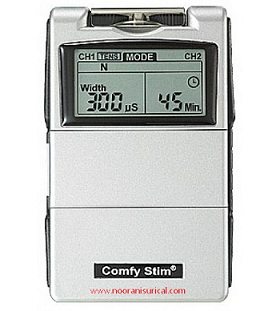Digital Stim also known as neuromuscular electrical stimulation (NMES) or electromyostimulation, is the elicitation of muscle contraction using electric impulses. EMS has received an increasing amount of attention in the last few years for many reasons: it can be utilized as a strength training tool for healthy subjects and athletes; it could be used as a rehabilitation and preventive tool for partially or totally immobilized patients; it could be utilized as a testing tool for evaluating the neural and/or muscular function in vivo; it could be used as a post-exercise recovery tool for athletes.[1] The impulses are generated by a device and are delivered through electrodes on the skin near to the muscles being stimulated.
The electrodes are generally pads that adhere to the skin. The impulses mimic the action potential that comes from the central nervous system, causing the muscles to contract. The use of EMS has been cited by sports scientists[2] as a complementary technique for sports training, and published research is available on the results obtained.[3] In the United States, EMS devices are regulated by the U.S. Food and Drug Administration (FDA).
In medicine, EMS is used for rehabilitation purposes, for instance in physical therapy in the prevention of disuse muscle atrophy which can occur for example after musculoskeletal injuries, such as damage to bones, joints, muscles, ligaments and tendons. This is distinct from transcutaneous electrical nerve stimulation (TENS), in which an electric current is used for pain therapy.
The FDA rejects certification of devices that claim weight reduction.[13] EMS devices cause a calorie burning that is marginal at best: calories are burnt in significant amount only when most of the body is involved in physical exercise: several muscles, the heart and the respiratory system are all engaged at once.[14] However, some authors imply that EMS can lead to exercise, since people toning their muscles with electrical stimulation are more likely afterwards to participate in sporting activities as the body becomes ready, fit, willing and able to take on physical activity.
“Strength training by NMES does promote neural and muscular adaptations that are complementary to the well-known effects of voluntary resistance training”.[1] This statement is part of the editorial summary of a 2010 world congress of researchers on the subject. Additional studies on practical applications, which came after that congress, pointed out important factors that make the difference between effective and ineffective EMS.[15][16] This in retrospect explains why in the past some researchers and practitioners obtained results that others could not reproduce. Also, as published by reputable universities, EMS causes adaptation, i.e. training, of muscle fibers.[17] Because of the characteristics of skeletal muscle fibers, different types of fibers can be activated to differing degrees by different types of EMS, and the modifications induced depend on the pattern of EMS activity.[18] These patterns, referred to as protocols or programs, will cause a different response from contraction of different fiber types. Some programs will improve fatigue resistance, i.e. endurance, others will increase force production.






Reviews
There are no reviews yet.